Raising Water Consciousness through
World’s Biggest Photo Exhibition and
Largest collection of Photo Stories on Water
Photo Stories | Water and Livelihood
Role of Water in the Success of Green Revolution in India
Nandita Singh and Om Prakash Singh
20 December, 2017
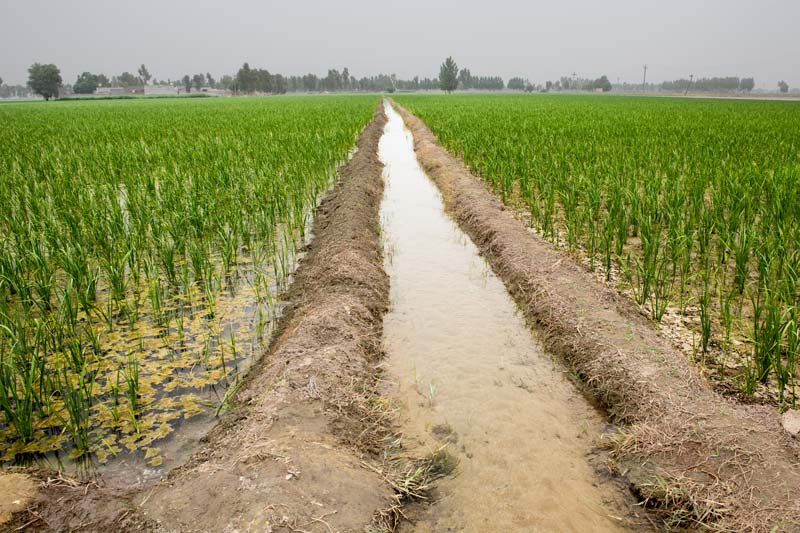
‘Green Revolution’ refers to a set of research and development initiatives relying primarily on new high-yielding varieties (HYVs) of foodgrains, credited to the American agronomist Norman Borlaug – who is recognized as the "Father of Green Revolution", for which he received the Nobel Peace Prize in 1970. In India, Green Revolution had its beginning in 1961 when on the brink of a famine, the Indian government and Ford Foundation collaborated to import new varieties of wheat seed from the International Maize and Wheat Improvement Center (CIMMYT) in Mexico and proceeded to try these in Punjab. Thereafter, India began its own Green Revolution program of plant breeding, irrigation development and financing of agrochemical production. Punjab, Haryana and Uttar Pradesh were the first states where Green Revolution was introduced, to be later extended to several other states across the country. Starting with wheat, it has come to include other foodgrains notably rice, maize as well as coarse grains like bajra (pearl millet), jowar (sorghum) and other millet varieties. For optimum productivity, the HYVs are dependent upon not only chemical fertilizers and agro-chemicals (herbicides and pesticides) but also reliable irrigation water. Further, higher annual productivity that is possible through multiple cropping in the same field during a year, is also dependent upon irrigation water. In fact, water is the most inalienable component of Green Revolution because not only is regular water supply a basic requirement for crop growth, but application of water in the right quantity and at the right time is essential for assuring yield stability. Therefore, given the seasonal nature and unreliability of Indian monsoon, as well as its high variability across different areas, Green Revolution in India came to be rooted in expansion of irrigation networks based on surface water as well as groundwater. Several multi-purpose projects as well as major and medium irrigation projects have been developed in major river basins. Several minor irrigation projects have also been developed, many of which are based on groundwater. A Centrally Sponsored Command Area Development Programme (CADP) was launched in 1974 to improve irrigation potential utilization and optimize agricultural production from irrigated land. As a result of the several state-initiated and private efforts, India’s irrigation-covered crop area has increased from about 22.6 million hectares (mha) in 1950-51 to a potential of 95.8 mha in 2013-14, and one-half to two-thirds of the increase in foodgrain production since the 1960s is accredited to this increase in irrigation coverage. This photo story aims to highlight the central role that water has played in making the Green Revolution a success in India, enabling it to become food-secure, raising the socio-economic status of the farmers, and making the country an important food exporter in the world. The title photo depicts a water channel in paddy fields fed by an irrigation canal in Fazilka district, Punjab. An efficient canal system has enabled this state to become the “granary of India” or “India's bread-basket” and the nucleus of Green Revolution.
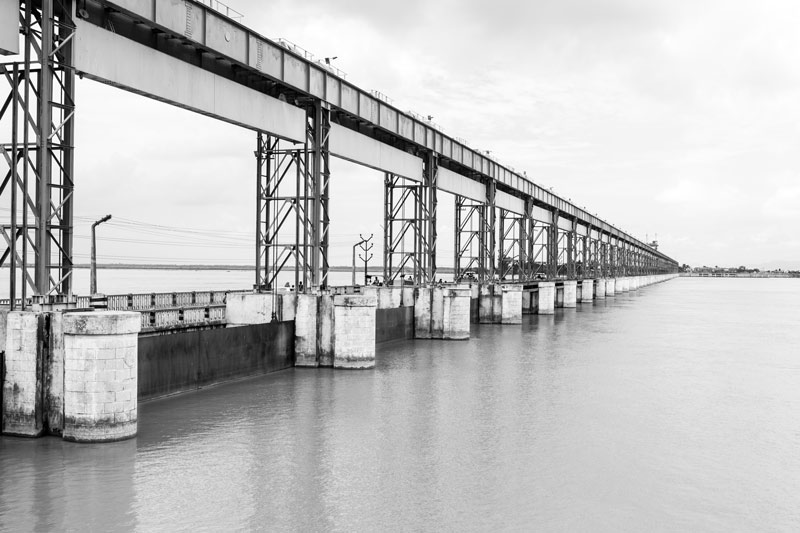
Kosi Barrage near Birpur, district Supaul, Bihar
In 1950-51, less than one-fifth of the cropped area in India was irrigated, which was a major impediment to improving the agricultural production. Consequently, during the first five year plan (1951-56), construction of a number of multipurpose projects as well as major and medium irrigation projects based on large dams was taken up. Projects which serve more than one purpose are called multipurpose projects, generally combining irrigation and hydro-power. Irrigation projects with a Culturable Command Area (CCA) between 2,000 and 10,000 hectares are classified as medium projects and those with CCA of more than 10,000 hectares as major projects. The first dams to be constructed in independent India included the Bhakra Nangal, Kosi, Chambal, Hirakud, Damodar Valley and Tungabhadra dams. Later many more were added and at present there exist 4877 large dams in the country, many of which are meant for irrigation. 1782 major and medium irrigation projects originate from these dams with large irrigation networks. These have significantly contributed to enhancing irrigated agriculture in the country, thereby promoting Green Revolution. The Kosi Barrage shown in the photo above was completed in 1964 as part of an international multipurpose project constructed by India across river Kosi, located in Nepal about 10 km away from the border at Birpur. Two major irrigation projects emerge from the Barrage on the Indian side, known as the Eastern Kosi and the Western Kosi Canals. The former has a CCA of 612 th ha while the latter has a planned CCA of 203 th ha, providing irrigation water in ten districts of North Bihar.
-5-copy-2.jpg)
An irrigation canal in Chandauli district, Uttar Pradesh
In Uttar Pradesh canals irrigate 2555 thousand hectares (th ha), primarily originating from 106 major and medium irrigation projects. 97 dams have been constructed in the state within the Ganga basin from which canal networks facilitate irrigation. Irrigation canal networks in Chandauli district as depicted in the photo above emerge from 4 dams, namely, Bhainsora, Chandraprabha, Moosakhand and Naugarh and the Narainpur Pump Canal Major Irrigation Project. These systems have a combined CCA of 122.86 th ha. In this rather low rainfall district where the average annual rainfall is only 497 mm, cultivation of HYVs of rice as the most important kharif (monsoon) crop, and of wheat as an important rabi (winter) crop has been possible only through facilitation of irrigation, through canals as well as other sources.
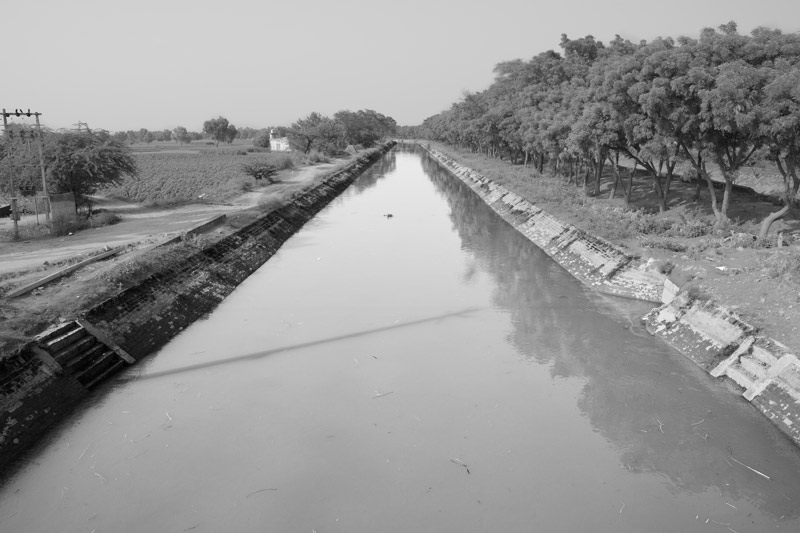
Sidhmukh irrigation canal in Fatehabad district, Haryana
Haryana was among the first states where Green Revolution was launched. Though the climate is semi-arid to arid with an average annual rainfall of barely 354 mm, canal irrigation in about 50% of the land, together with use of groundwater-based irrigation has enabled it to become an important producer of wheat and rice. One of the Major irrigation projects benefiting the farmers of the state is the Sidhmukh Project depicted in the photo above. It brings irrigation water from Ravi-Beas rivers and serves Hissar and Fatehabad districts of Haryana as well as parts of Rajasthan. The CCA of this project is 80 th ha. Irrigation water from this canal enables multiple cropping in the rather water scarce district of Fatehabad. The District falls in semi-arid type agro-climatic zone and has soil type ranging from sandy to clay. The cultivated area is 100% irrigated, of which 48.9% is irrigated by canal. The major food crops produced in the district are wheat, paddy, bajra, barley and jowar which make agriculture a profitable livelihood in this otherwise harsh agro-climatic zone.
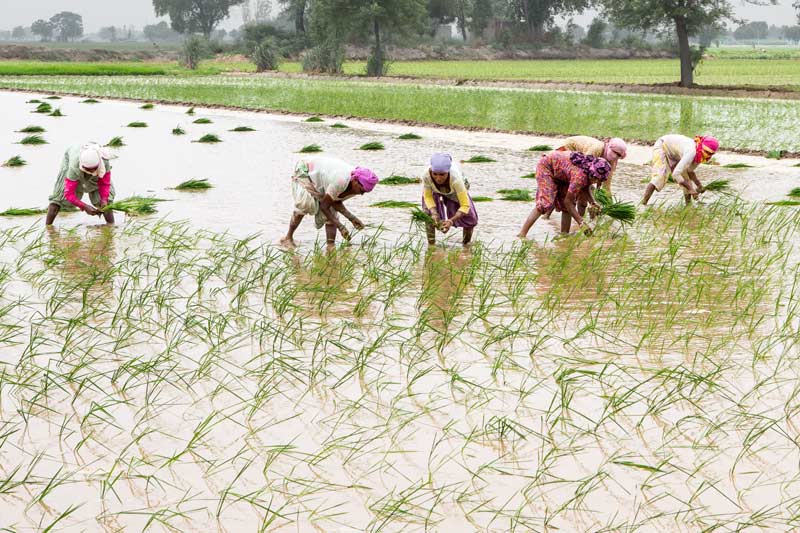
Paddy transplantation in Bathinda district, Punjab
The land area of Punjab is just 1.4% of total area of India, but irrigated agriculture here enables multiple cropping, producing roughly 12% of the total cereal production in the country. Wheat and rice are the major cereals produced. A large part of Punjab is characterized by fertile alluvial soils but deficient in rainfall, average annual rainfall being only 499 mm. The rainfall deficiency is compensated by a rich canal network emerging from the perennial rivers of the Indus system, and groundwater-based irrigation. There are 18 major and medium irrigation projects in the state, most of which have been constructed in the post-independence period, both before and after the launch of Green Revolution. Irrigated agriculture has enabled Punjab to become the third largest producer of rice in the country, with paddy transplantation in flooded fields as shown in the photo above. The crop occupies the second rank in state as per area covered (2831 th ha) under it and in 2014-15 the production was 11.11 million tonnes (MT).
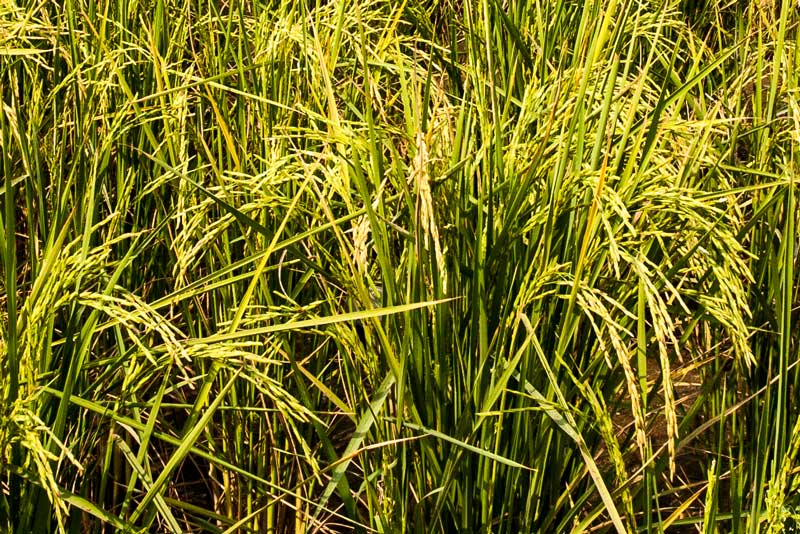
Matured paddy crop in Bathinda district, Punjab
Punjab has not been a rice growing area in the past. However, expansion of irrigation canals and accessibility to groundwater through tubewells has enabled cultivation of HYVs of this crop in the state, even in the southwestern Malwa region, where the rainfall is considerably low as well as the soil quality is poor in substantial parts. In Bathinda district in this region, paddy is grown on loamy and sandy soils amidst an average annual rainfall less than 600 mm. Despite the agro-climatic mismatch, irrigated cropping of HYVs of rice has enabled farmers in this district to reap great profits, the net return per hectare from paddy being Rs 19,826 (approx. 309.35 USD) in 2010-11. Paddy is the second most important crop in the district.
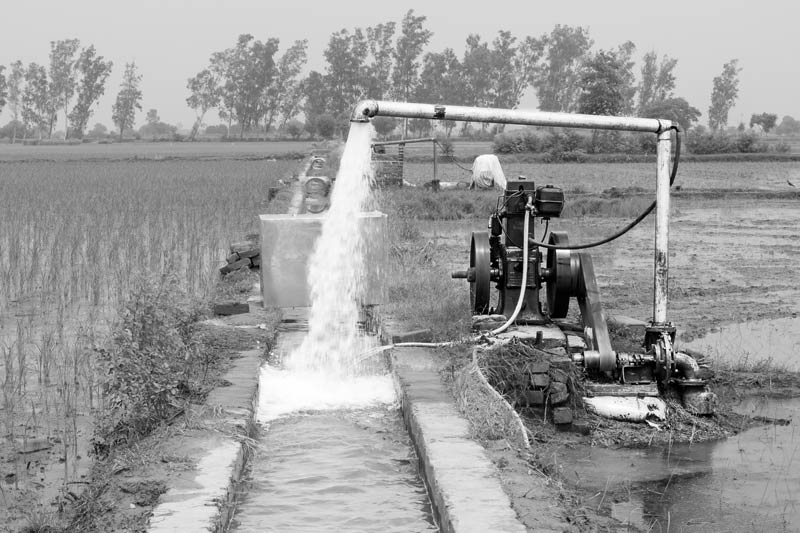
A private deep tubewell with diesel pumpset in Rohtak district, Haryana
Apart from canal irrigation, Green Revolution has also been promoted through groundwater-based irrigation. While a number of minor irrigation projects based on groundwater, having a command area of less than 2000 ha, have been established by the government, drilling of private tubewells has also contributed significantly to spread of the Green Revolution. Today more than 50 % of the irrigated area in the country depends on groundwater and in several districts it is more than 80%. Groundwater-based irrigation is generally developed where canal irrigation is absent, or else in canal networks areas where the canal water supply is limited or untimely such as in tail end villages. The number of tubewells owned by cultivators is increasing rapidly. Through tubewells farmers can exercise a better control over irrigation water and maximize profit from multiple cropping with a minimum risk of loss in crop production on account of water scarcity. Taking the example of Rohtak district as shown in the photo above, out of total irrigated area of 97900 ha, 31000 ha is tube-well irrigated. There exist 20045 shallow irrigation tube wells in the district, out of which 3106 are electric motor driven and 16939 are diesel engine units. These are generally drilled upto a depth of 20 m as salinity increases with greater depth. Bajra, Jowar and paddy are the major kharif foodcrops, while wheat is the major rabi foodgrain grown in the district.
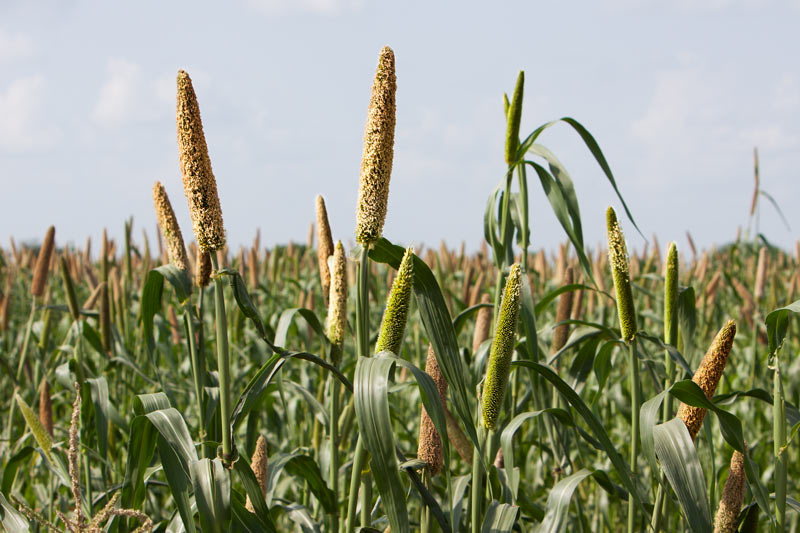
Bajra crop in Rohtak district, Haryana
Bajra is an important coarse grain that was included in the Green Revolution. India is the first country to develop HYVs of this crop which resulted in an increase in production from 2.84 MT in 1950 to nearly 9.18 MT in 2014-15. The newly developed HYVs are predominantly suitable for drought prone areas, which can also be grown as irrigated crop. The share of irrigated sown area for the crop has increased in the country from 3.4% to 9%. It is mainly grown as an irrigated crop in states like Telangana, Haryana, Andhra Pradesh and Gujarat. In Telangana more than 67% of the cropped area under bajra is irrigated while in Haryana it is over 42%. In Andhra Pradesh and Gujarat the irrigated area is over 22%.
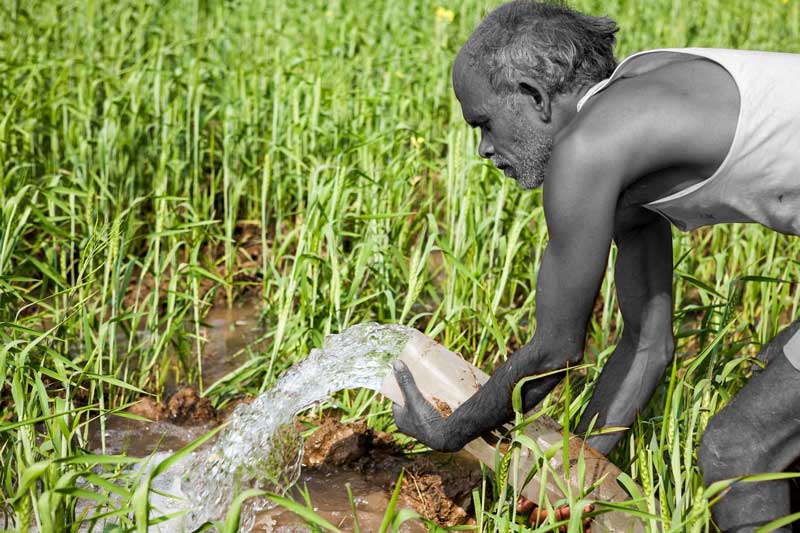
Irrigating wheat fields with tubewell water in Bhojpur district, Bihar
Wheat is second most important foodcrop in India in terms of production but before Green Revolution, wheat happened to be only a marginal crop in the country, mainly concentrated in the north-western pocket. However, adoption of irrigated cultivation of HYVs of wheat first in the state of Punjab followed by Haryana and Uttar Pradesh, ushered in a new phase of wheat production in the country. Subsequently, wheat cultivation under Green Revolution came to be extended all over the country, particularly in the eastern states such as Bihar. In Bihar 59 Major and Medium irrigation projects have helped facilitate Green Revolution in about 57% of its gross cultivated area. In the remaining areas, groundwater-based irrigation has been developed. Wheat cultivation in Bihar was earlier limited but after adoption of irrigated cropping under Green Revolution, wheat has come to be planted on a larger scale, and now occupies the status of a major rabi crop in the state.
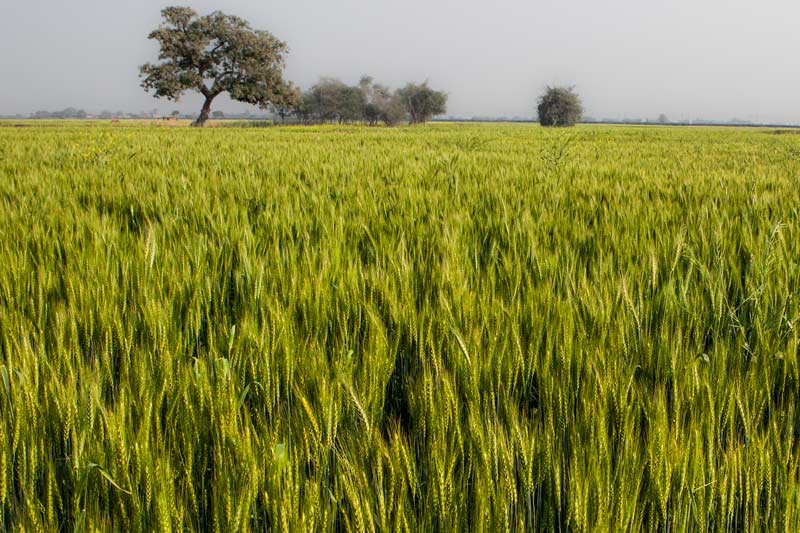
Wheat fields in Bhojpur district, Bihar
Wheat cultivation in Bihar has been facilitated with canal as well as groundwater-based irrigation, making it the second most important crop in the state in terms of cropped area as well as production. The state is the sixth largest producer of wheat in the country, having an average annual production of approximately 4 MT. Cultivation of HYVs of wheat has been widely adopted, replacing the traditional mixed cropping pattern of Bengal gram, mustard, peas and wheat. In Bhojpur district, wheat is the second most important crop grown.
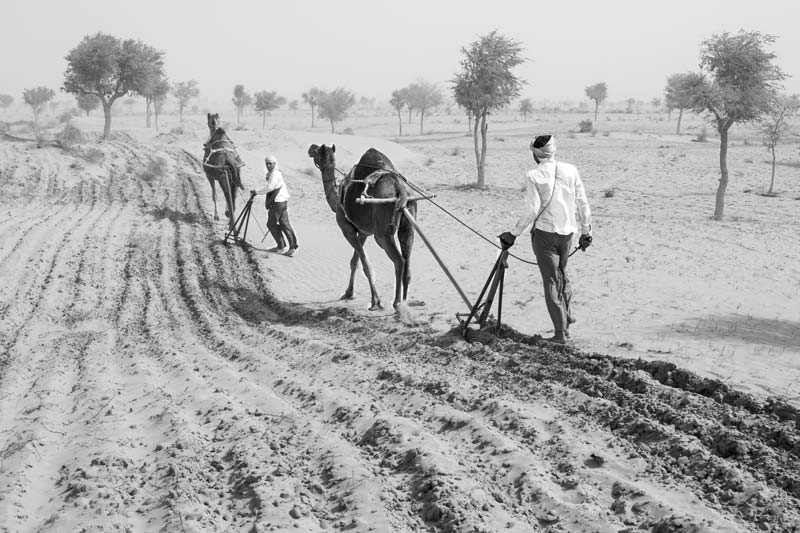
Ploughing a sandy field in Thar Desert in Bikaner district, Rajasthan
The districts of Bikaner, Jaisalmer, Barmer and Hanumangarh in Rajasthan are characterised by sandy soil as these are part of the Thar Desert. Originally, it was possible to grow only one kharif crop in these areas, the common crops being rain-fed bajra (pearl millet), moth (Turkish bean or Dew bean) and guar (Cluster Bean). With a scanty rainfall - 250 mm or less in a year – and droughts every 2-3 years, stability of agriculture as a livelihood option was very low. In order to change the agricultural scenario in the Thar Desert and to raise the socio-economic status of the farmers as well as the self-sufficiency in foodgrains, a major intervention introduced here was the Green Revolution.
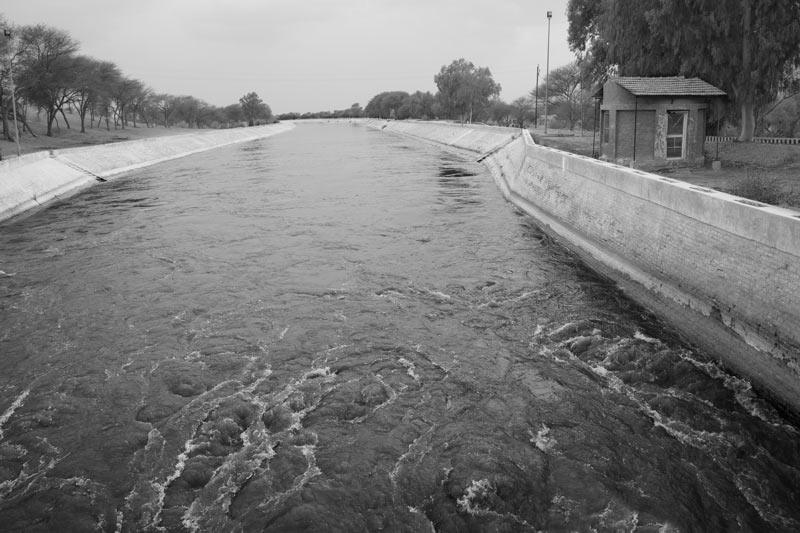
The Main Canal of the Indira Gandhi Canal Project in Bikaner district, Rajasthan
In order to improve agricultural production in the desert districts of Rajasthan, a major initiative of the government was to bring Sutlej water from Punjab to Thar desert area in Rajasthan through the Indira Gandhi Canal (IGC) Project. For this purpose, Harike Barrage was constructed at 3 km downstream of confluence of the rivers Sutlej and Beas in Punjab. The IGC Project was started in the year 1957 and has a total CCA of 1769 th ha. Its stage - I comprises of the 204 km long feeder canal and 189 km long main canal, along with 3454 km long distributaries. The construction of the Rajasthan Feeder Canal commenced in 1958 and was completed by 1964. The IGC traverses seven districts comprising Thar Desert of Rajasthan: Barmer, Bikaner, Churu, Hanumangarh, Jaisalmer, Jodhpur, and Sriganganagar. The IGC project has significantly supported Green Revolution in the state, transforming many barren desert stretches of these districts into productive fields, with multiple cropping practiced.
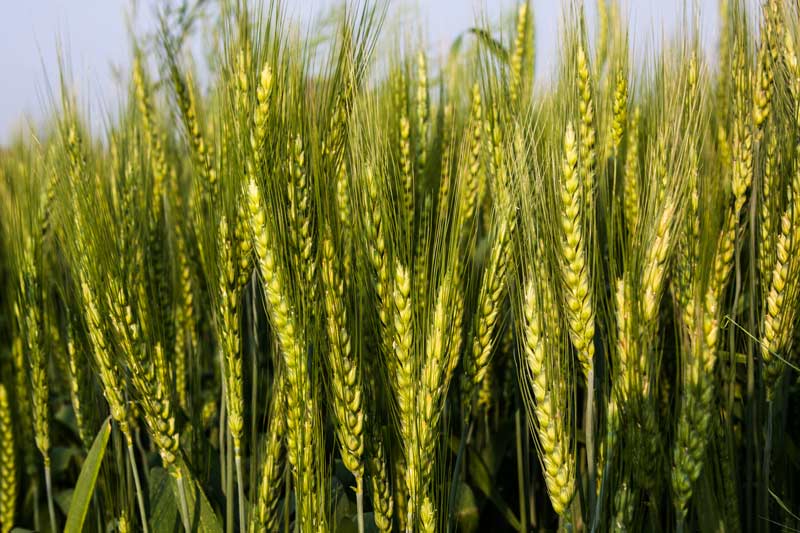
Wheat crop in Bikaner district, Rajasthan
In Thar Desert cultivation of rabi crop was traditionally possible only in the khadin-irrigated areas. Khadin refers to the traditional irrigation system where rabi crop used to be grown in large tanks that had moist beds after draining out the rainwater stored inside during the monsoon season. Coming of the IGC project has enabled production of wheat as the major rabi crop in the command area located within the desert which basically consists of poor quality sandy soil. Production of wheat as a major rabi crop was not possible before the coming of IGC. In Bikaner district, 357.3 th ha of land is irrigated, of which as much as 240.3 th ha (64%) is irrigated by canals and 134.9 th ha (36%) is irrigated by borewells. Over 79 th ha of this irrigated land is sown with wheat, mostly irrigated by the IGC. The average production of wheat in the district during the period 2003-04 to 2007-08 was 92000 tonnes, which contributes to making Rajasthan the fifth largest wheat producing state in India.
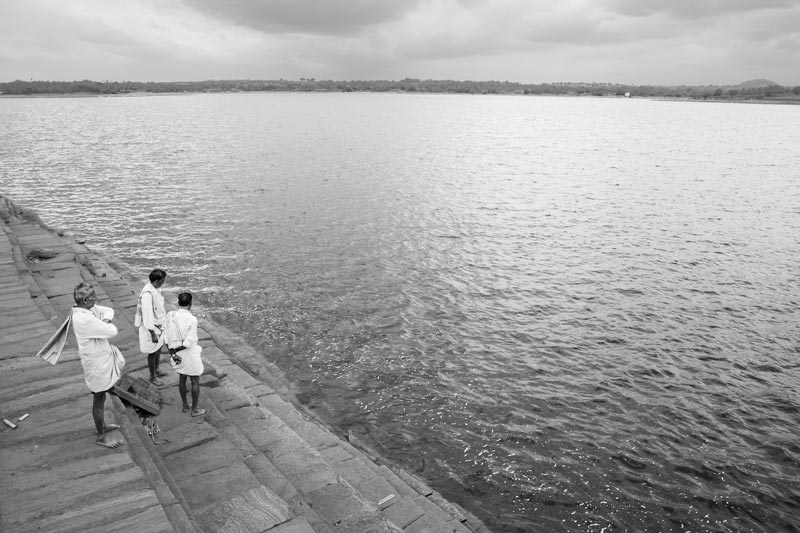
Thonnur Kere - an irrigation tank in Mandya district, Karnataka
Tank irrigation is a prominent practice in southern India since perennial river flows are limited. Canal networks arising from irrigation tanks are quite common in the region. In Karnataka, tank irrigation covers more than 80% of the irrigated area which has helped promote Green Revolution in the state. Thonnur Kere shown in the above photo is a large irrigation tank with a catchment area of 58.58 sq. km and a waterspread area of more than 419 ha. The tank has been renovated in recent years with development of irrigation network that has significantly supported Green Revolution in the area.
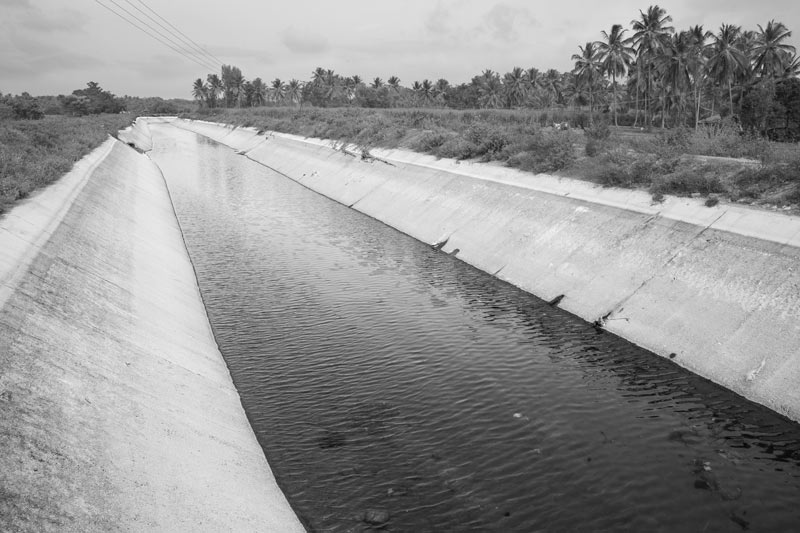
The main canal carrying irrigation water from Thonnur Kere in Mandya district, Karnataka
Though Thonnur Kere was constructed in the 11th Century, to support Green Revolution in the area an elaborate irrigation network has been added to the tank. The main canal emerging from the Thonnur Kere shown in the above photo has a length of 2.6 km. It supplies irrigation water in 287 ha of agricultural land which is used for growing paddy, jowar, ragi and maize as food crops, besides other crops.
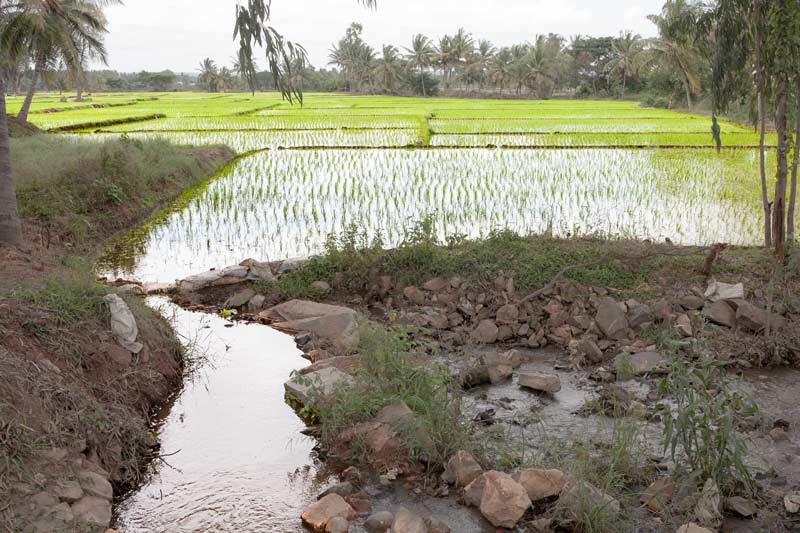
A channel supplying irrigation water into fields from the main canal of Thonnur Kere in Mandya district, Karnataka
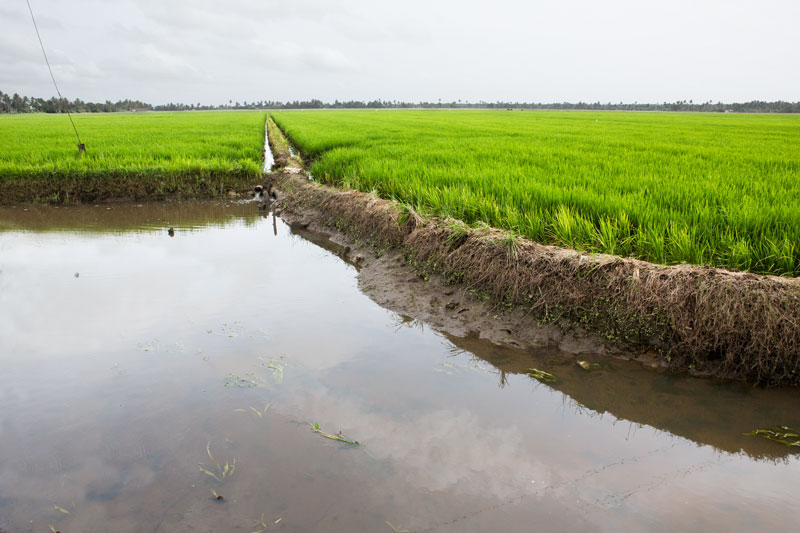
Paddy fields in wetlands below mean sea level in Kuttanad region in Alappuzzha district, Kerala
Alappuzha district is a part of ‘Kuttanad’ region of Kerala where paddy cultivation has been traditionally carried out in polders located about 0.6 to 2.2 m below mean sea level (MSL). Kuttanad is the deltaic formation extending over 874 sq.km. where four major river systems, namely, Pampa, Achencoil, Manimala and Meenachil, confluence into the Vembanad Lake. The polders where paddy cultivation is practiced have been reclaimed primarily from the lake bed, and unlike ordinary irrigated paddy cultivation, in Kuttanad excess of water that enetrs the polders from the Lake needs to be pumped out from the fields at regular intervals through a network of channels as shown in the photo above. Due to location below MSL, the productivity of paddy was limited with only one crop a year sown post-monsoon in Oct-Nov and harvested in February (referred to as the ‘summer' crop). With a view to improve the production of paddy here, Green Revolution was launched through introduction of HYVs after 1962-63.
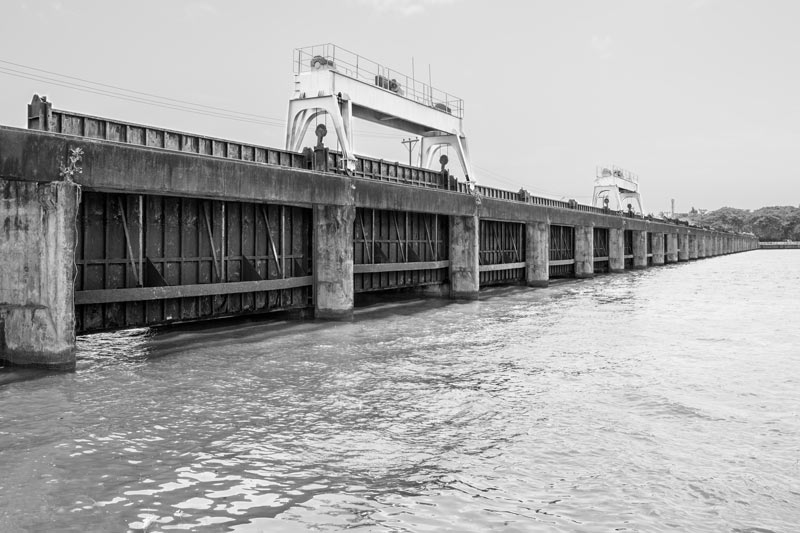
Seaside view of Thanneermukkom Saltwater Barrier in Alappuzha district, Kerala
In order to enable maximum benefits from the HYVs of paddy within the special circumstances of Kuttanad region as described above, the Thanneermukkom Saltwater Barrier was constructed in Alappuzzha district in 1974. It is a structure built across the Vembanad Lake, dividing the Lake into two parts - one half with brackish water perennially (on the sea side) and the other half with fresh water fed by the rivers draining into the lake (on the land side). Earlier a major limitation to agricultural development in the region was salinity ingress into the Lake during the dry months in December-April, when the lake’s water level was lowered making sea water to enter the Lake. Due to this reason water could not be taken from the lake for irrigation during the dry season, in turn forcing the farmers to grow only one paddy crop in a year. The construction of the Saltwater Barrier has facilitated the cultivation of a second paddy crop by keeping the water in the Lake area free of salinity. This has facilitated the cultivation of the second paddy crop since now fresh water can be drawn from the Lake for irrigation during the dry period. The gates of the Barrier remain closed from mid-November until July, and during monsoons, two-thirds of the gates are opened to allow release into the sea of the excess flood flow coming into the Lake from the rivers draining into it.
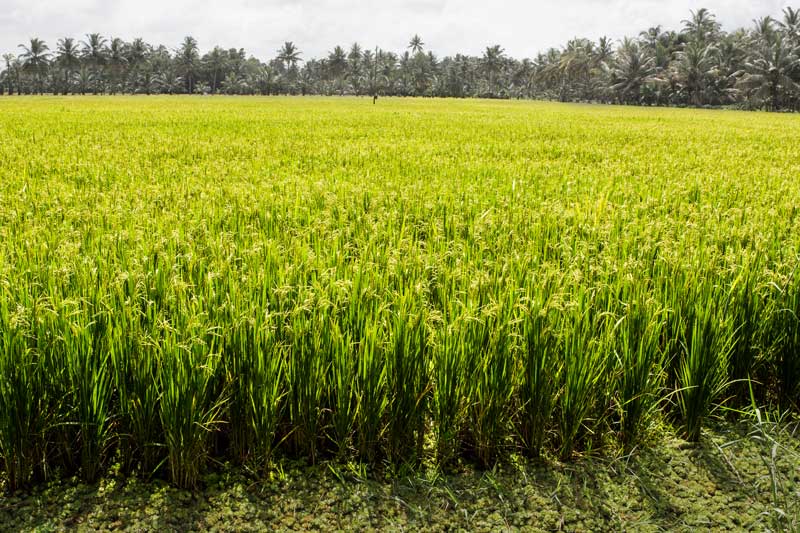
Paddy fields in wetlands below mean sea level in Alappuzzha district, Kerala
As a result of the developments in the Kuttanad region under the Green Revolution including construction of the Saltwater Barrier as described above, high yielding dwarf varieties of paddy were adopted and a second crop started being sown with a cycle from May/June to September/October, using freshwater irrigation drawn from the Lake during the dry months. This transformed the expanse of paddy cultivation which during 1966 over an area of only 4000 ha to increase to the present status of 10,000 ha. The Green Revolution has enabled Kuttanad to become the ‘rice bowl’ of Kerala, contributing 25% of paddy production in the state.
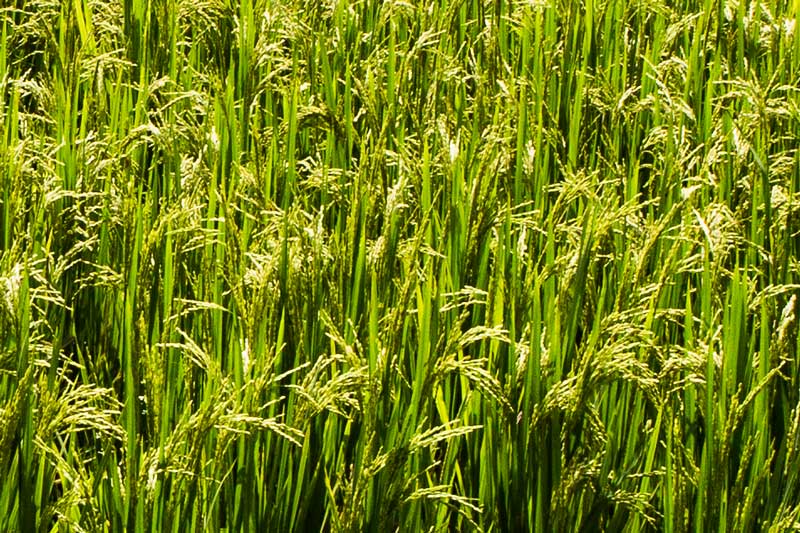
Paddy crop in wetlands below mean sea level in Alappuzzha district, Kerala
This photo story exemplifies how water has played a central role in making the Green Revolution a success in India. Since the launch of Green Revolution, the irrigated cropped area as well as agricultural production in the country has increased manifold. In 1950-51, the area under foodgrain production was 97.32 mha, of which only 18.1% was irrigated. In 2013-14, the area under foodgrain production stood at 125.04 mha, of which as much as 51.9% is irrigated, on which HYVs of foodgrains is largely grown. Comparing total foodgrain production since the beginning of the Green Revolution, in 1966-67 it was only 74.23 MT, which has risen to 265.04 MT in 2013-14, registering an increase of 257%. Regarding wheat, in 1966-67 it was only 11.39 MT which reached up to 95.85 MT in 2013-14, registering an increase of over 742 %. The corresponding figures for rice production were 30.44 MT and 106.65 MT for the same reference period, registering an increase of over 250 %. The yield of wheat increased from 887 kg per hectare in 1966-67 to over 3146 kg per hectare by 2013-14 while that of rice has risen from 864 kg per hectare to 2416 kg per hectare during the same period. Though availability of HYV seeds and of fertilizers and agro-chemicals are important factors behind the success of Green Revolution, the correlation between irrigation and agricultural productivity becomes evident from the above figures. Not only has the cropped area under foodgrains increased, but the share of irrigated land has increased dramatically. It can be further observed that even if HYV seeds are available alongwith adequate supplies of fertilizers, herbicides and pesticides, in the absence of adequate water at the right time due to delayed or failure of rainfall or interrupted canal irrigation, or failure of electricity for running tubewells, or inoperational pumpsets due to high diesel prices, or even drying of tubewells due to depletion of groundwater, crop failure is imminent. Also several instances of farmer suicides are known to be linked to crop failure, which in turn are based in recurrent droughts. All these observations further attest the importance of water as a central factor underlying the success of Green Revolution. In fact it has been argued that Green Revolution in India has not occurred on unirrigated lands. The success of Green Revolution has enabled widespread agricultural development in the country, bringing new livelihood opportunities and higher incomes for farmers, rise in real wages of agricultural laborers and also decline of rural poverty, besides ushering in foodgrain self-sufficiency in the country. It has helped establish India as one of the world's biggest agricultural producers, making it one of largest food grains exporters in the world. No other country which attempted the Green Revolution has recorded such level of success. Given the centrality of water in success of the Green Revolution in the country, however, it is important to consider that if this pace of agricultural progress is to be continued, care needs to be taken to use water for irrigation with utmost prudence, particularly since water is a finite resource and 54% of the country is already known to be facing high to extremely high water stress. In this context, introduction of new HYV seeds of foodgrains that are low water-intensive and drought-resistant is a need of the time.